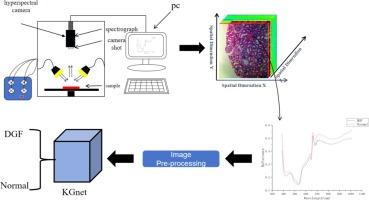Using hyperspectral imaging to predict the occurrence of delayed graft function
IF 4.3
2区 化学
Q1 SPECTROSCOPY
Spectrochimica Acta Part A: Molecular and Biomolecular Spectroscopy
Pub Date : 2024-10-28
DOI:10.1016/j.saa.2024.125350
引用次数: 0
Abstract
Delayed Graft Function (DGF) is a prevalent complication in kidney transplantation (KT) that significantly affects allograft function and patient prognosis. Early and precise identification of DGF is crucial for improving post-transplant outcomes. In this study, we present KGnet, a predictive model leveraging hyperspectral imaging (HSI) to assess delayed graft function status. We analyzed 72 zero-hour biopsy samples from transplanted kidneys with confirmed pathological diagnoses, capturing spectral data across a wavelength range of 400 to 1000 nm. By examining spectral signatures related to tissue oxygenation, perfusion, and metabolic states, our approach enabled the detection of subtle biochemical changes indicative of DGF risk. The preprocessed spectral data were input into KGnet, achieving a prediction accuracy of 94 % for DGF occurrence, significantly outperforming existing predictive models. This study identifies key spectral signatures associated with DGF, allowing for precise risk prediction even before clinical symptoms emerge. Leveraging HSI for early detection introduces a novel pathway for individualized post-transplant management, offering substantial potential to enhance kidney transplantation outcomes and patient quality of life. These findings highlight significant clinical and research implications for the broader application of HSI in transplant medicine.

利用高光谱成像预测移植功能延迟的发生
移植物功能延迟(DGF)是肾移植(KT)中普遍存在的一种并发症,严重影响同种异体移植物的功能和患者的预后。早期准确识别 DGF 对改善移植后预后至关重要。在本研究中,我们介绍了一种利用高光谱成像(HSI)评估延迟移植物功能状态的预测模型 KGnet。我们分析了 72 个经病理确诊的移植肾的零小时活检样本,采集了波长范围为 400 到 1000 nm 的光谱数据。通过检查与组织氧合、灌注和新陈代谢状态相关的光谱特征,我们的方法能够检测出表明DGF风险的微妙生化变化。将预处理后的光谱数据输入 KGnet,DGF 发生率的预测准确率达到 94%,明显优于现有的预测模型。这项研究确定了与 DGF 相关的关键光谱特征,甚至在临床症状出现之前就能进行精确的风险预测。利用 HSI 进行早期检测为个体化移植后管理提供了一条新途径,为提高肾移植效果和患者生活质量提供了巨大潜力。这些发现凸显了 HSI 在移植医学中更广泛应用的重要临床和研究意义。
本文章由计算机程序翻译,如有差异,请以英文原文为准。
求助全文
约1分钟内获得全文
求助全文
来源期刊
CiteScore
8.40
自引率
11.40%
发文量
1364
审稿时长
40 days
期刊介绍:
Spectrochimica Acta, Part A: Molecular and Biomolecular Spectroscopy (SAA) is an interdisciplinary journal which spans from basic to applied aspects of optical spectroscopy in chemistry, medicine, biology, and materials science.
The journal publishes original scientific papers that feature high-quality spectroscopic data and analysis. From the broad range of optical spectroscopies, the emphasis is on electronic, vibrational or rotational spectra of molecules, rather than on spectroscopy based on magnetic moments.
Criteria for publication in SAA are novelty, uniqueness, and outstanding quality. Routine applications of spectroscopic techniques and computational methods are not appropriate.
Topics of particular interest of Spectrochimica Acta Part A include, but are not limited to:
Spectroscopy and dynamics of bioanalytical, biomedical, environmental, and atmospheric sciences,
Novel experimental techniques or instrumentation for molecular spectroscopy,
Novel theoretical and computational methods,
Novel applications in photochemistry and photobiology,
Novel interpretational approaches as well as advances in data analysis based on electronic or vibrational spectroscopy.

 求助内容:
求助内容: 应助结果提醒方式:
应助结果提醒方式:


